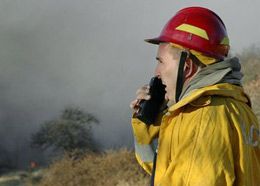 AP Photo/Mark Zimmerman An Oklahoma City firefighter talks on his radio to report a hot spot during a grass fire in 2005. |
Communications is “the exchange of information.” To communicate is “to make known, or to transmit information or thoughts so that it is satisfactorily received or understood,” according to a dictionary definition.
The need for standardized radio communication procedures and language has long been recognized as the vital link to a safe and effective fireground operation.
As firefighters, we believe that we see and hear every detail in our world. But we actually miss a lot. That’s because the fireground is a dynamic environment that rapidly affects all of our senses. Most of us see and hear what we expect to, or want to, and often filter out or perceive inaccurately what we are not expecting. Perception can be very powerful, and dangerous.
There are many parts missing in what we see and hear, but we don’t realize it. What we say is often not what the other person hears — just ask your family. Creating a standard operating procedure for radio communications, including common verbiage, will make errors and confusion much less likely on the fireground. Clear and consistent radio communication is vital to safe operations.
Locating an occupant while searching a building that is heavily involved in fire is a time where clear communication must happen quickly and correctly, in a format that everyone on scene understands. Can you imagine this scene if the company officer leading the search team said on the radio something like, “Hey, we found someone; we’re coming out.” Imagine the incident commander hearing,” … someone … coming out,” and just continuing the operation while waiting for someone to bring somebody out somewhere.
Speaking the same language should be the foundation of any radio communication procedure. The three most important words in this procedure should be “to,” “from,” and “on.” Here’s a few ways to use them:
• Connecting one radio to another radio:
o Engine 33 connecting to dispatch using “to-from": “Dispatch from Engine 33"
o Dispatch answering Engine 33: “Engine 33"
o Hearing your designator first, in this case, “Dispatch,” grabs your attention
• An arrival report:
o “Dispatch, Engine 33 arrival, fire venting from one window on side A on floor 2"
• A progress/situation report:
o A rescue crew beginning a primary search:
o “Command from Rescue 33, starting primary search from side A on floor two”
• From the scenario above. where the search team finds an occupant:
o “Command from Rescue 33"
o “Rescue 33" (Command answers)
o “Rescue 33 has located one unconscious occupant. Exiting with occupant from floor two to floor one on Side A. Need EMS.”
A good progress/situation report will include the conditions that you are experiencing, the actions you are taking, any known or possible safety problems, all relevant information, and any needs, which should be solutions, not problems.
In a high risk environment, such as the fireground, the best way to prevent errors and increase performance is to have understandable communication. Maximizing crew performance doesn’t come from finding the “best” way of doing things, it comes from everyone knowing and following “good” procedures. Communication is greatly enhanced by standard operating procedures and common terminology. We need to listen up, be brief, and be consistent.











